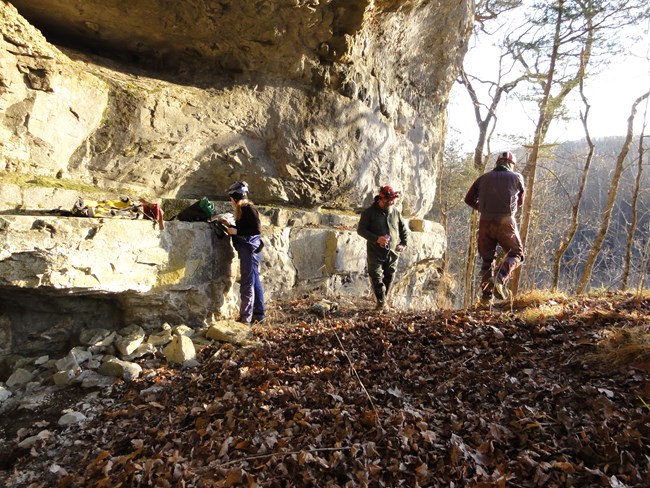
NPS Photo
Located in south-central Kentucky, Mammoth Cave National Park is the largest unit of the Cumberland Piedmont Network with 53,000 acres of forested hills, two rivers, and the longest recorded cave system in the world. The cave ecosystem is considered one of the world's most diverse, and the park also contains tremendous above-ground diversity. Rivers, bluffs, sinkholes, cave entrances, and ridgetops all are habitats with many distinct plant and animal communities.
The Cumberland Piedmont Network I&M program has provided this park with a vegetation community classification and map, an upland-wetland inventory, and updated vascular plant and vertebrate species lists. During the vegetation community classification work, over 42 distinct associations were documented and mapped, including rare limestone glades and post oak barrens.
The network monitoring program at this park includes nine vital signs that involve repeated visits to established sites, following procedures established by each monitoring protocol. These nine vital signs include five cave vital signs (aquatic biota, bats, crickets, meteorology, woodrats), forest vegetation communities, invasive species early detection, ozone/foliar injury, and water quality. Water quality monitoring (ongoing in this park for over a decade prior to establishment of the network), continued in 2004 through network monitoring protocols, which followed the schedule for two years "on", five years "off", at 13 sites. Forest monitoring began in 2011–2012 with the establishment of 16 long-term monitoring plots, and continues on a yearly schedule with site visits in September. This park has a continuous ozone monitor and foliar injury is assessed on-site every year, beginning in 2008. The Invasive Species Early Detection protocol was completed in 2012 and will be used by field crews to monitor for priority exotics during their scheduled field work. Cave bat monitoring began in 2016 and continues annually for summer counts and every other year for winter counts. Cave cricket monitoring began in 2018 and continues annually for summer and winter counts. The cave aquatic biota monitoring protocol was completed in 2018.
Park managers are using inventory and monitoring data to create resource stewardship strategies for achieving desired future conditions. For example, a critically important issue for this park is cave bat monitoring. White-nose Syndrome is a devastating fungal disease killing millions of bats across the United States. This disease was documented for the first time at this park in 2013, following monitoring visits to several of the park caves. This long-term dataset is extremely important in understanding impacts to this vital cave resource.
Park managers are using inventory and monitoring data to create resource stewardship strategies for achieving desired future conditions. The links to inventory and monitoring reports are provided on this page.
For more Information contact:
Steve Thomas, Network Program Manager, CUPN offices at Mammoth Cave NP
Select a Park:
Select a Species Category (optional):
Visit NPSpecies for more comprehensive information and advanced search capability. Have a suggestion or comment on this list? Let us know.
Last updated: January 13, 2021
